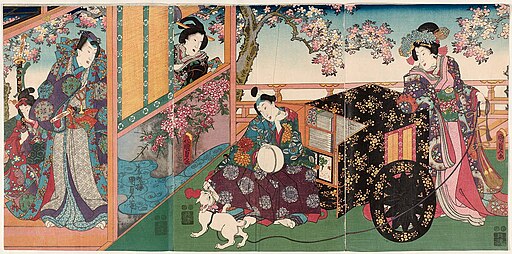Kirschblüten of Berlin
In 1990, following the reunification of Germany, the Japanese television station TV-Asahi launched a fundraising campaign to collect money for planting Japanese cherry trees in Germany. Enough donations were collected for over 9,000 trees, a large portion of which were sent to Berlin.
The first trees were planted in November 1990 at Glienicke Bridge, a symbolic site of German division during the Cold War. Today, many cherry trees can be found in the former border strip, as well as in parks and public facilities throughout the city. At the site of the so-called “death strip” that ran parallel to the Berlin Wall to prevent escape attempts, Japanese citizens planted a thousand cherry trees. Since 1996, this long avenue of Japanese cherry trees has been known as “Japaneck” or Japanese Corner.

Hanami tradition in Ancient Japan
In Japan, cherry blossoms are more than just pretty trees. They’re the main focus of an old tradition called “Hanami,” which means “flower viewing.” This tradition has deep cultural and philosophical meaning beyond just looking at flowers. Hanami is a long-standing Japanese tradition that welcomes spring by appreciating the beauty of flowers, particularly cherry blossoms, known as “sakura,” and occasionally plum blossoms, called “ume.” This custom celebrates the fleeting beauty of these flowers and their deep connection to nature and human life.
Hanami began over 1,000 years ago in Japan’s Nara period, from the early eighth century to the late eighth century. Back then, Japanese nobles copied Chinese customs and held plum blossom viewing parties. Later, during the Heian period, from the late eighth century to the late twelfth century, cherry blossoms became the main focus of these celebrations instead. During the Heian period, aristocrats and poets began holding flower-viewing parties beneath the cherry blossom trees. These gatherings highlighted the symbolic significance of the blossoms and gradually spread to all segments of society.

SIGNIFICANCE IN ANIME
Cherry blossoms (sakura) in anime symbolize life’s impermanence, new beginnings, and emotional depth. Their brief bloom parallels poignant moments like Kaori’s story in “Your Lie in April” and marks transitions like school beginnings in “My Hero Academia.” Falling petals enhance romance in “5 Centimeters Per Second” and “Cardcaptor Sakura,” where the magical girl herself is named after these iconic flowers. In “Naruto,” they highlight Itachi’s sacrifice. More than pretty backgrounds, sakura serve as powerful visual shorthand for life’s most meaningful transitions and emotions.

SAKURA IN ANCIENT MYTHOLOGY
In Japanese mythology, there’s a goddess called Konohanasakuya-hime who is the deity of Mount Fuji and all volcanoes. She is also known as the blossom-princess and symbolizes delicate earthly life. Often considered an avatar of Japanese life itself, her symbol is, fittingly, the sakura or cherry blossom.
Shinto shrines dedicated to Sakuya-hime have been built on Mount Fuji, collectively known as the Asama or Sengen Shrines. People believe she prevents Mount Fuji from erupting, although shrines to her at Kirishima have been repeatedly destroyed by volcanic eruptions. She’s also famous for having torn up the Yatsugatake Mountains because they were higher than her beloved Fujiyama.

POTENTIAL HEALTH BENEFITS
P. serrulata, one species of cherry blossom, is used in Chinese traditional medicine. It’s believed that the plant’s potential therapeutic benefits against various illnesses stem from the presence of many bioactive compounds, including antioxidants, vitamins, and minerals. In Oriental medicine, this tree’s edible fruits are used as an emmenagogue—a substance that stimulates or regulates menstrual flow. It’s also used to treat mastitis, dropsy, and heart failure.
Recent scientific studies have shown that pink cherry blossoms contain many bioactive chemical compounds that may have anticancer, antioxidant, and antiviral activities. Research suggests potential benefits for heart problems, neurological issues, and even certain skin diseases.
REFERENCES:
Nie, C., Zhang, Y., Zhang, X., Xia, W., Sun, H., Zhang, S., Li, N., Ding, Z., Lv, Y., Wang, N., 2023. Plant Journal 114, 519–533.
Kanazawa, Y., Kameyama, Y., Li, J., Hamano, C., Suzuki, K., 2016. Horticultural Research (japan) 15, 129–138.
Song, Y., Cheng, Z., Idrees, M., Yi, X., Wang, X., Li, M., 2023. Botanical Journal of the Linnean Society 204, 304–315.
Shen, X., Zong, W., Li, Y., Liu, X., Zhuge, F., Zhou, Q., Zhou, S., Jiang, D., 2023. International Journal of Molecular Sciences.
Chen, T., Chen, Q., Zhang, J., Wang, Y., Wang, H., Zhang, Y., Luo, Y., Tang, H., Wang, X., 2023. Plants 12, 2258.
Dong, J., Yi, X.-G., Wang, X., Li, M., Chen, X., Gao, S., Fu, W., Qian, S., Zeng, X., Yun, Y., 2024. Plants.
https://thursd.com/articles/japanese-floral-celebration-hanami
Christenhusz, M.J.M., van Uffelen, G.A., 2001. Gorteria 27, 97–108.
Isajev, V., Stankovic, M., Orlović, S., Bojić, S., Stojnic, S., 2018. 2.
2022. Japanese society and culture.
Gaur, R. and Sharma, Y., 2025. Botanical, phytochemical and pharmacological aspects of Prunus Serrulata: A traditional medicinal plant of China. Ann Tradit Chin Med, 2(1), p.1004.

Leave a Reply